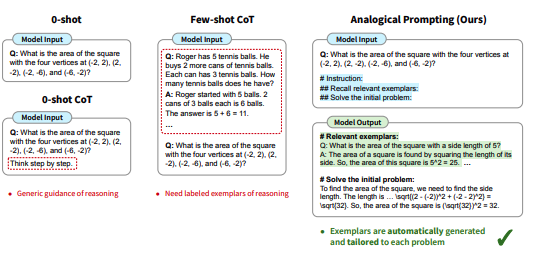Generate Examples First
Analogical Prompting1 is a method that aims to get LLMs to generate examples that are relevant to the problem before starting to address the user's query.
This takes advantage of the various forms of knowledge that the LLM has acquired during training and explicitly prompts them to recall the relevant problems and solutions. We can use Analogical Prompting using the following template

Analogical Prompting Prompt Template
Problem: [User Prompt]
Relevant Problems: Recall three relevant and distinct problems. For each problem, describe it and explain the solution
Solve the problem
We can implement this using instructor as seen below with some slight modifications.
from pydantic import BaseModel, Field
import instructor
from textwrap import dedent
client = instructor.from_provider("openai/gpt-5-nano")
class RelevantProblem(BaseModel):
problem_explanation: str
solution: str
class Response(BaseModel):
relevant_problems: list[RelevantProblem] = Field(
max_length=3,
min_length=3,
)
answer: RelevantProblem
def analogical_prompting(query: str):
return client.create(
messages=[
{
"role": "user",
"content": dedent(
f"""
<problem>
{query}
</problem>
Relevant Problems: Recall three relevant and
distinct problems. For each problem, describe
it and explain the solution before solving
the problem
"""
),
}
],
model="gpt-4o",
response_model=Response,
)
if __name__ == "__main__":
query = (
"What is the area of the square with the four "
"vertices at (-2, 2), (2, -2), (-2, -6), and "
"(-6, -2)?"
)
response = analogical_prompting(query)
for problem in response.relevant_problems:
print(problem.model_dump_json(indent=2))
"""
{
"problem_explanation": "Determine the distance
between two points in a coordinate plane.",
"solution": "To find the distance between two
points, use the distance formula: \\(d =
\\sqrt{(x_2 - x_1)^2 + (y_2 - y_1)^2}\\). This
formula calculates the Euclidean distance between
points (x_1, y_1) and (x_2, y_2)."
}
"""
"""
{
"problem_explanation": "Calculate the area of a
square given its side length.",
"solution": "The area of a square can be found
using the formula: \\(A = s^2\\), where \\(s\\) is
the length of one side of the square."
}
"""
"""
{
"problem_explanation": "Identify vertices and
properties of a geometry shape such as
parallelogram.",
"solution": "For any quadrilateral, verify that
all sides are equal and angles are right angles to
confirm it is a square. Use properties of
quadrilaterals and distance formula."
}
"""
print(response.answer.model_dump_json(indent=2))
"""
{
"problem_explanation": "Calculate the area of a
square given its vertices.",
"solution": "First, confirm the shape is a square by
checking the distance between consecutive vertices
and ensuring all sides are of equal length using the
distance formula. For vertices (-2,2), (2,-2),
(-2,-6), and (-6,-2), calculate distances between
consecutive points. If distances are equal, use the
side length to compute area using \\(A = s^2\\)."
}
"""